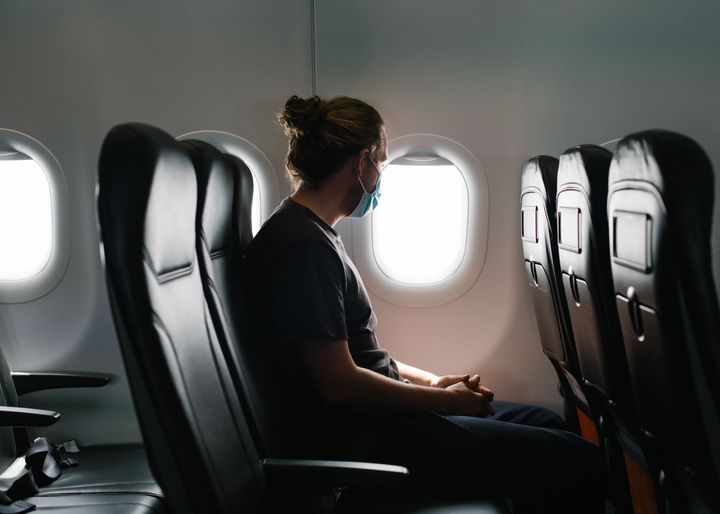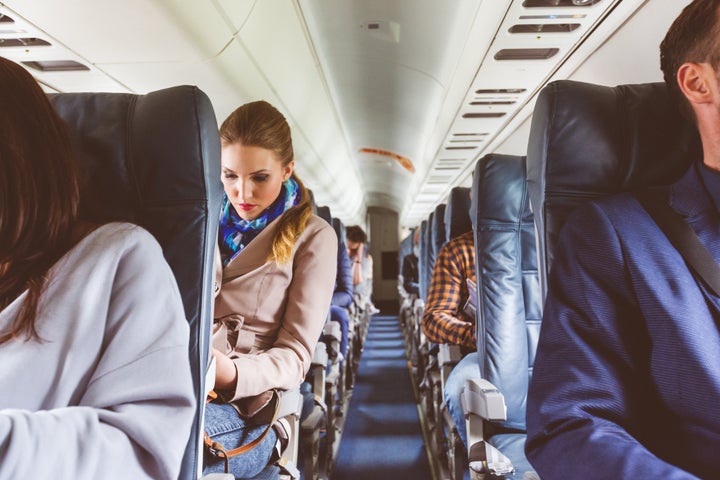
During college, I grew a tumour that meant I hung out quite frequently in MRI machines. Though I’d never had a problem before, I found myself newly and severely claustrophobic – laying in a tiny tunnel for hours, arms raised overhead, will do that.
What I never saw coming was that phobia transferring to other small spaces, namely, airplanes. I’d developed severe anxiety around flying, stemming from that claustrophobia. Once the flight attendants closed the doors, and I was stuck there for a few hours, I was history. Since then, I’ve been on a mission to overcome flight anxiety because who wants to hang out in the Midwest their whole life?
It turns out I’m far from alone — up to 40% of Americans (and one in 10 Brits) have some sort of flying anxiety, from fearing a plane crash to worries about close contact with others. Or, like me, they don’t want to be stuck. Still, others dread navigating the airport, worrying their valuables might be lost or that they could encounter an issue with security doubting their intentions. Flying anxiety has become such an issue that some airlines like British Airways even offer courses, such as their Flying with Confidence one-day class, to get you back in the air.
There’s likely even more of a spike in flight anxiety thanks to the pandemic, according to Susan Zinn, a psychotherapist and author of “The Epiphanies Project.”
“That is why there’s been an uptick in airplane phobias, fear of flying, and feeling out of control, or road or flight rage — people all of a sudden get triggered that bring them back to a time in our recent past where they felt so out of control,” Zinn said.
Here’s what experts say we can do to reduce our anxieties about airplanes.
Expose yourself to the aspects of flying (preferably with a mental health professional)
For Johnny Jet, a worldwide traveler and expert who has been to over 70 countries, his traveling fears started with a doctor’s comment. He was headed on a 27-hour flight when his asthma doctor commented that he “might have a problem breathing on a plane because the cabin is pressurised.”
This led to a full-blown panic attack at a New York airport ahead of the flight, which he called “one of the worst days of his life,” and prompted an almost four-year-long fear of flying.
Exposure to planes and airports ended up being, ironically, part of the solution. “Speak to the flight crew, take a course, read books, go to the airport and do practice runs,” he suggested.
This type of activity ― known as exposure therapy ― can help your brain adapt to the situation over time and take some of the fear and uncertainty away from flying. It’s best to try this with a therapist who is trained in doing this.
Zinn added that medication might also be necessary for some people in tandem with preparation. She’s worked with clients who have spent several months practicing for a flight before the real trip.
Get strategic about your seat selection
Right after 9/11, Zinn had to jump on a plane out of New York for a business trip. She was terrified as their flight was escorted by air marshals openly carrying weapons. She was one of many who would develop a new fear of flying, which caused nausea and panic attacks.
One strategy that helped her was carefully picking a seat that made her feel comfortable. “I always still to this day will sit on the outside aisle [seat] to make sure I can always get up, versus kind of being stuck on the inside, which made me feel better,” she said.
Quick access to the bathroom, where you can splash cold water on your face to “shock your system” when you feel panic is another tool that helps, Zinn explained. If financially possible, upgrading to first class for more room or choosing an exit row for more legroom might also help, Jet added.

Find a deep breathing method that works for you
It may be an annoying suggestion to hear, but breathing exercises are often given as a recommendation for anxiety because they work. Zinn said she often suggests her patients practice intentional breathing exercises, like five-finger breathing, where you take deep inhales and exhales as you trace the outline of your hand.
Doing this can help calm the panic that arises before it turns into a full panic attack, Zinn said.
Pack some sour candy in your carry on
Zinn also suggested eating some sour candy, such as a WarHead, to force your brain back into reality. The candy’s tartness can help you better focus on the moment rather than the fear or “what if?” during flying. It’s another way to practice mindfulness.
Learn the “why” behind air bumps
Adam Banks, a retired pilot based in New York, said the turbulence is one of the most concerning parts of flying for anxious passengers. Understanding what it is might help you see it as more normal and less of a sign of impending doom.
“Turbulence is just shifting winds. If you fly into a puffy cloud, the airplane is going to get a bump,” he said. “Airplanes are designed to handle these bumps. If you’re sitting over the wing, you can see the wings flex as they absorb turbulence. Turbulence might feel like the airplane is moving around thousands of feet, the reality is the airplane is probably only being jostled a few feet.”
Ground yourself in facts
Zinn said that dealing with both physical anxiety and our mind’s perception of danger plays a role in calming down, so statistics might help. For example, the annual risk of dying in a plane crash is only one in 11 million. You are much more likely to die from sunstroke, a bee sting, consuming a hot substance or even being attacked by a dog.
For me, flying in a tiny space will probably always be a struggle. But armed with some tools and tricks, flying is doable again, and I’m no longer doomed to the Midwest for life.